2cdccf75cfbaa043739c9a40adec61fc.ppt
- Количество слайдов: 86
 Author(s): Joseph Fantone, MD, 2009 License: Unless otherwise noted, this material is made available under the terms of the Creative Commons Attribution–Non-commercial–Share Alike 3. 0 License: http: //creativecommons. org/licenses/by-nc-sa/3. 0/ We have reviewed this material in accordance with U. S. Copyright Law and have tried to maximize your ability to use, share, and adapt it. The citation key on the following slide provides information about how you may share and adapt this material. Copyright holders of content included in this material should contact open. michigan@umich. edu with any questions, corrections, or clarification regarding the use of content. For more information about how to cite these materials visit http: //open. umich. edu/education/about/terms-of-use. Any medical information in this material is intended to inform and educate and is not a tool for self-diagnosis or a replacement for medical evaluation, advice, diagnosis or treatment by a healthcare professional. Please speak to your physician if you have questions about your medical condition. Viewer discretion is advised: Some medical content is graphic and may not be suitable for all viewers.
Author(s): Joseph Fantone, MD, 2009 License: Unless otherwise noted, this material is made available under the terms of the Creative Commons Attribution–Non-commercial–Share Alike 3. 0 License: http: //creativecommons. org/licenses/by-nc-sa/3. 0/ We have reviewed this material in accordance with U. S. Copyright Law and have tried to maximize your ability to use, share, and adapt it. The citation key on the following slide provides information about how you may share and adapt this material. Copyright holders of content included in this material should contact open. michigan@umich. edu with any questions, corrections, or clarification regarding the use of content. For more information about how to cite these materials visit http: //open. umich. edu/education/about/terms-of-use. Any medical information in this material is intended to inform and educate and is not a tool for self-diagnosis or a replacement for medical evaluation, advice, diagnosis or treatment by a healthcare professional. Please speak to your physician if you have questions about your medical condition. Viewer discretion is advised: Some medical content is graphic and may not be suitable for all viewers.
 Citation Key for more information see: http: //open. umich. edu/wiki/Citation. Policy Use + Share + Adapt { Content the copyright holder, author, or law permits you to use, share and adapt. } Public Domain – Government: Works that are produced by the U. S. Government. (USC 17 § 105) Public Domain – Expired: Works that are no longer protected due to an expired copyright term. Public Domain – Self Dedicated: Works that a copyright holder has dedicated to the public domain. Creative Commons – Zero Waiver Creative Commons – Attribution License Creative Commons – Attribution Share Alike License Creative Commons – Attribution Noncommercial Share Alike License GNU – Free Documentation License Make Your Own Assessment { Content Open. Michigan believes can be used, shared, and adapted because it is ineligible for copyright. } Public Domain – Ineligible: Works that are ineligible for copyright protection in the U. S. (USC 17 § 102(b)) *laws in your jurisdiction may differ { Content Open. Michigan has used under a Fair Use determination. } Fair Use: Use of works that is determined to be Fair consistent with the U. S. Copyright Act. (USC 17 § 107) *laws in your jurisdiction may differ Our determination DOES NOT mean that all uses of this 3 rd-party content are Fair Uses and we DO NOT guarantee that your use of the content is Fair. To use this content you should do your own independent analysis to determine whether or not your use will be Fair.
Citation Key for more information see: http: //open. umich. edu/wiki/Citation. Policy Use + Share + Adapt { Content the copyright holder, author, or law permits you to use, share and adapt. } Public Domain – Government: Works that are produced by the U. S. Government. (USC 17 § 105) Public Domain – Expired: Works that are no longer protected due to an expired copyright term. Public Domain – Self Dedicated: Works that a copyright holder has dedicated to the public domain. Creative Commons – Zero Waiver Creative Commons – Attribution License Creative Commons – Attribution Share Alike License Creative Commons – Attribution Noncommercial Share Alike License GNU – Free Documentation License Make Your Own Assessment { Content Open. Michigan believes can be used, shared, and adapted because it is ineligible for copyright. } Public Domain – Ineligible: Works that are ineligible for copyright protection in the U. S. (USC 17 § 102(b)) *laws in your jurisdiction may differ { Content Open. Michigan has used under a Fair Use determination. } Fair Use: Use of works that is determined to be Fair consistent with the U. S. Copyright Act. (USC 17 § 107) *laws in your jurisdiction may differ Our determination DOES NOT mean that all uses of this 3 rd-party content are Fair Uses and we DO NOT guarantee that your use of the content is Fair. To use this content you should do your own independent analysis to determine whether or not your use will be Fair.
 Classification of Immune Mediated Tissue Injury: Gell Coombs Classification Mechanisms of Immune-Mediated Disorders (4 - types) J. Fantone: Host Defense 2/17/09 10: 00 -12: 00 am Winter 2009
Classification of Immune Mediated Tissue Injury: Gell Coombs Classification Mechanisms of Immune-Mediated Disorders (4 - types) J. Fantone: Host Defense 2/17/09 10: 00 -12: 00 am Winter 2009
 The four types of hypersensitivity reaction type ll allergen cell surface antigen lg. G target cell K lg. E cytotoxic action antibody Fc receptor mast cell degranulation mediator release complement mediated lysis type lll immune-complex deposition target cell type l. V antigens complement T inflammatory mediators blood vessel tissue basement membrane Source Undetermined lymphokines activated macrophage
The four types of hypersensitivity reaction type ll allergen cell surface antigen lg. G target cell K lg. E cytotoxic action antibody Fc receptor mast cell degranulation mediator release complement mediated lysis type lll immune-complex deposition target cell type l. V antigens complement T inflammatory mediators blood vessel tissue basement membrane Source Undetermined lymphokines activated macrophage
 Type I Anaphylactic Type • Prototype Disorders – Allergic rhinnitis – Allergic asthma – Anaphylaxis (insect venom) • Immune Mechanisms – Ig. E-Mast cells – Vascular permeability – Eosinophils
Type I Anaphylactic Type • Prototype Disorders – Allergic rhinnitis – Allergic asthma – Anaphylaxis (insect venom) • Immune Mechanisms – Ig. E-Mast cells – Vascular permeability – Eosinophils
 Type II, Cytotoxic Type • Prototype Disorders • Immune Mechanisms – Hemolytic reactions – Ig. G – Goodpastures Syndrome – Complement – Myasthenia Gravis – Phagocytic cells – Grave’s Disease – ADCC (hyperthyroidism)
Type II, Cytotoxic Type • Prototype Disorders • Immune Mechanisms – Hemolytic reactions – Ig. G – Goodpastures Syndrome – Complement – Myasthenia Gravis – Phagocytic cells – Grave’s Disease – ADCC (hyperthyroidism)
 Type III, Immune Complex Disease • Prototype Disorders – Post-streptococcal glomerulonephritis – Vasculitis • Polyarteritis nodosa • Immune Mechanisms – Ab-Ag reactions – Complement – Neutrophils – Fibrin, hemorrhage
Type III, Immune Complex Disease • Prototype Disorders – Post-streptococcal glomerulonephritis – Vasculitis • Polyarteritis nodosa • Immune Mechanisms – Ab-Ag reactions – Complement – Neutrophils – Fibrin, hemorrhage
 Type IV, Cell-Mediated (Delayed) Hypersensitivity • Prototype Disorders • Immune Mechanisms – Poison Ivy – T-lymphocytes – Tuberculosis (granulomatous – Monocyte/macroinflammation) phage – Cytotoxic T-cell • Dr. King’s lectures
Type IV, Cell-Mediated (Delayed) Hypersensitivity • Prototype Disorders • Immune Mechanisms – Poison Ivy – T-lymphocytes – Tuberculosis (granulomatous – Monocyte/macroinflammation) phage – Cytotoxic T-cell • Dr. King’s lectures
 Antibody-Mediated Cell and Tissue Injury: Ig. E Mediated Hypersensitivity Reactions Objectives: To understand the pathophysiologic mechanisms associated with Type I anaphylactic hypersensitivity reactions
Antibody-Mediated Cell and Tissue Injury: Ig. E Mediated Hypersensitivity Reactions Objectives: To understand the pathophysiologic mechanisms associated with Type I anaphylactic hypersensitivity reactions
 Objectives (cont. ) • The role of Ig. E-mediated Mast cell degranulation in Type I reactions • The primary effector mediators released during Mast cell stimulation • The pathologic changes observed in tissues associated with anaphylactic hypersensitivity reactions • The modulatory role of eosinophils in these reactions • To correlate the effect of mediators on target organs with the clinical expression of anaphylactic reactions
Objectives (cont. ) • The role of Ig. E-mediated Mast cell degranulation in Type I reactions • The primary effector mediators released during Mast cell stimulation • The pathologic changes observed in tissues associated with anaphylactic hypersensitivity reactions • The modulatory role of eosinophils in these reactions • To correlate the effect of mediators on target organs with the clinical expression of anaphylactic reactions
 Clinical • Type I reactions are usually the result of exposure to environmental allergens in genetically susceptible individuals • 1/10 persons in USA affected to varying degrees • Genetics not clearly defined, although there is a familial association • Atopy: a genetic predisposition for developing Ig. E responses to many antigens • Local or systemic symptoms
Clinical • Type I reactions are usually the result of exposure to environmental allergens in genetically susceptible individuals • 1/10 persons in USA affected to varying degrees • Genetics not clearly defined, although there is a familial association • Atopy: a genetic predisposition for developing Ig. E responses to many antigens • Local or systemic symptoms
 Clinical (cont. ) • Most common form - allergic rhinnitis – Also • • • Certain types of asthma Atopic dermatitis (eczema) Certain gastrointestinal food allergies • Allergens – Pollens, molds, house dust mite, animal dander
Clinical (cont. ) • Most common form - allergic rhinnitis – Also • • • Certain types of asthma Atopic dermatitis (eczema) Certain gastrointestinal food allergies • Allergens – Pollens, molds, house dust mite, animal dander
 Source Undetermined
Source Undetermined
 Pathophysiology Induction and effector mechanisms in Type l Hypersensitivity antigen APC pharmacological effects blood vessels airways etc. cell infiltration (see Fig. 19. 22) processing and presentation lg. E TH IL-4 Be cytokines IFNy preformed and newly formed mediators Ca 2+ l l. L-4, l. L-5, l. L-6 antigen presentation Source Undetermined lg. E production l. L-3, l. L-4 GM-CSF, TNFa l. L-8/9, inflammatory cell activation mast cell activation mediator release clinical effects asthma eczema hay fever (see Fig. 19. 23) feedback effects on the immune system (see FSig. 19. 23) clinical effects
Pathophysiology Induction and effector mechanisms in Type l Hypersensitivity antigen APC pharmacological effects blood vessels airways etc. cell infiltration (see Fig. 19. 22) processing and presentation lg. E TH IL-4 Be cytokines IFNy preformed and newly formed mediators Ca 2+ l l. L-4, l. L-5, l. L-6 antigen presentation Source Undetermined lg. E production l. L-3, l. L-4 GM-CSF, TNFa l. L-8/9, inflammatory cell activation mast cell activation mediator release clinical effects asthma eczema hay fever (see Fig. 19. 23) feedback effects on the immune system (see FSig. 19. 23) clinical effects
 Sensitization to Ag B-cell proliferation with production of Ig. E (IL-4 driven process) Ig. E binds to surface of mast cell or basophil Second Ag challenge Multivalent Ag binds Ig. E on mast cells: crosslinking Ig. E Degranulation and release of preformed mediators De novo synthesis of mediators
Sensitization to Ag B-cell proliferation with production of Ig. E (IL-4 driven process) Ig. E binds to surface of mast cell or basophil Second Ag challenge Multivalent Ag binds Ig. E on mast cells: crosslinking Ig. E Degranulation and release of preformed mediators De novo synthesis of mediators
 Degranulation and release of preformed mediators Histamine Chemotactic factors Proteases De novo synthesis of mediators Leukotrienes (C 4, D 4, E 4) Prostaglandins Platelet activating factor Cytokines Smooth muscle: bronchial, GI, vascular Vascular endothelium Secretory glands (e. g. mucous) Eosinophils
Degranulation and release of preformed mediators Histamine Chemotactic factors Proteases De novo synthesis of mediators Leukotrienes (C 4, D 4, E 4) Prostaglandins Platelet activating factor Cytokines Smooth muscle: bronchial, GI, vascular Vascular endothelium Secretory glands (e. g. mucous) Eosinophils
 Resting mast cell Fce receptor Activated mast cell lg. E antibody Resting mast cell shows granules containing serotonin and histamine Multivalent antigen crosslinks bound lg. E antibody causing release of granule contents
Resting mast cell Fce receptor Activated mast cell lg. E antibody Resting mast cell shows granules containing serotonin and histamine Multivalent antigen crosslinks bound lg. E antibody causing release of granule contents
 Effects of Mediators in Anaphylaxis: Reversible Response • Histamine - vascular permeability, vasodilation (post-capillary venule), smooth muscle contraction • Chemotactic Factors • Cytokines • Lipid mediators
Effects of Mediators in Anaphylaxis: Reversible Response • Histamine - vascular permeability, vasodilation (post-capillary venule), smooth muscle contraction • Chemotactic Factors • Cytokines • Lipid mediators
 Effects of Mediators in Anaphylaxis: Reversible Response (cont. ) • Lipid Mediators: Arachidonic acid metabolites – Leukotriene C 4, D 4, E 4 - smooth muscle contraction – Prostaglandins - vasodilation
Effects of Mediators in Anaphylaxis: Reversible Response (cont. ) • Lipid Mediators: Arachidonic acid metabolites – Leukotriene C 4, D 4, E 4 - smooth muscle contraction – Prostaglandins - vasodilation
 Effects of Mediators in Anaphylaxis: Reversible Response (cont. ) • Lipid Mediators: PAF - platelet activating factor - low molecular weight lipid – Acetylated glycerol ether phosphocholine (AGEPC) – Activates phagocytic cells – Smooth muscle contraction
Effects of Mediators in Anaphylaxis: Reversible Response (cont. ) • Lipid Mediators: PAF - platelet activating factor - low molecular weight lipid – Acetylated glycerol ether phosphocholine (AGEPC) – Activates phagocytic cells – Smooth muscle contraction
 Role of Eosinophils in Anaphylaxis: • Normal levels 2 to 3% circulating leukocytes • Type 1 response: up to 10%+ circulating leukocytes • Secretory products include: – – – NADPH oxidase-derived oxidants Prostaglandins and Leukotrienes (LTC 4) Major basic protein (MBP): cytotoxic Cytokines others
Role of Eosinophils in Anaphylaxis: • Normal levels 2 to 3% circulating leukocytes • Type 1 response: up to 10%+ circulating leukocytes • Secretory products include: – – – NADPH oxidase-derived oxidants Prostaglandins and Leukotrienes (LTC 4) Major basic protein (MBP): cytotoxic Cytokines others
 J. Fantone
J. Fantone
 Pathologic Changes Associated with Anaphylactic Reactions: Reversible • Symptoms depend on target organ: skin – Gross: swelling, wheal and flare response • early response: preformed mediators • late response: synthesized mediators – Light microscopic: edema, eosinophils – Electron microscopic: edema, endothelial cell gaps
Pathologic Changes Associated with Anaphylactic Reactions: Reversible • Symptoms depend on target organ: skin – Gross: swelling, wheal and flare response • early response: preformed mediators • late response: synthesized mediators – Light microscopic: edema, eosinophils – Electron microscopic: edema, endothelial cell gaps
 Source Undetermined
Source Undetermined
 Pathologic Changes Associated with Anaphylactic Reactions: Reversible • Mucous and serous glands – Increased secretion • Bronchial and GI smooth muscle – Contraction
Pathologic Changes Associated with Anaphylactic Reactions: Reversible • Mucous and serous glands – Increased secretion • Bronchial and GI smooth muscle – Contraction
 Therapeutic Approaches • Avoid antigen • Mediator antagonists – anti-histamines: receptor antagonist – leukotriene inhibitors: lipase inhibitors, receptor antagonists – functional: sympathetic stimulants • Inhibit mast cell degranulation – cromolyn • Non-specific anti-inflammatory agents – corticosteroids • Immunotherapy (“allergy shots”)
Therapeutic Approaches • Avoid antigen • Mediator antagonists – anti-histamines: receptor antagonist – leukotriene inhibitors: lipase inhibitors, receptor antagonists – functional: sympathetic stimulants • Inhibit mast cell degranulation – cromolyn • Non-specific anti-inflammatory agents – corticosteroids • Immunotherapy (“allergy shots”)
 Comparison of Skin Tests Hypersensitivity Type 1 Time Features Minutes Wheal: edema Flare: vasodilation Eosinophils
Comparison of Skin Tests Hypersensitivity Type 1 Time Features Minutes Wheal: edema Flare: vasodilation Eosinophils
 Diagnosis • Skin test - most frequently used Source Undetermined
Diagnosis • Skin test - most frequently used Source Undetermined
 Serologic Tests: RAST - Radioallergosorbent Test - Specific Ig. E + Patient’s serum (Ab) Bead with Ag J. Fantone Anti-human Ig. E
Serologic Tests: RAST - Radioallergosorbent Test - Specific Ig. E + Patient’s serum (Ab) Bead with Ag J. Fantone Anti-human Ig. E
 RIST - Radioimmunosorbent Test - Total Ig. E + Patient’s serum (Ab) Bead + Anti human Ig. E Anti-human Ig. E J. Fantone
RIST - Radioimmunosorbent Test - Total Ig. E + Patient’s serum (Ab) Bead + Anti human Ig. E Anti-human Ig. E J. Fantone
 Summary: Type I Reaction • Antibody: Ig. E • Effector Cells: Mast Cell & Eosinophil • Complement: No • Reaction: Minutes
Summary: Type I Reaction • Antibody: Ig. E • Effector Cells: Mast Cell & Eosinophil • Complement: No • Reaction: Minutes
 Antibody-Mediated Cell and Tissue Injury (Type II and Type III Reactions)
Antibody-Mediated Cell and Tissue Injury (Type II and Type III Reactions)
 The four types of hypersensitivity reaction type ll allergen cell surface antigen lg. G target cell K lg. E cytotoxic action antibody Fc receptor mast cell degranulation mediator release complement mediated lysis type lll immune-complex deposition target cell type l. V antigens complement T inflammatory mediators blood vessel tissue basement membrane Source Undetermined lymphokines activated macrophage
The four types of hypersensitivity reaction type ll allergen cell surface antigen lg. G target cell K lg. E cytotoxic action antibody Fc receptor mast cell degranulation mediator release complement mediated lysis type lll immune-complex deposition target cell type l. V antigens complement T inflammatory mediators blood vessel tissue basement membrane Source Undetermined lymphokines activated macrophage
 Pathophysiology • Cytotoxic or Type II Reactions: Binding of Antibody (Ig. G or Ig. M) with cell membrane or tissue antigens – Red blood cell membrane antigens - hemolytic anemias – Platelet antigens - thrombocytopenia cell membrane - petechial hemorrhage – Basement Membrane - Goodpasture’s syndrome • Kidney - proteinuria • Lung - hemorrhage
Pathophysiology • Cytotoxic or Type II Reactions: Binding of Antibody (Ig. G or Ig. M) with cell membrane or tissue antigens – Red blood cell membrane antigens - hemolytic anemias – Platelet antigens - thrombocytopenia cell membrane - petechial hemorrhage – Basement Membrane - Goodpasture’s syndrome • Kidney - proteinuria • Lung - hemorrhage
 Mechanisms • • • Opsonin dependent phagocytosis Complement-dependent Ab lysis Antibody-dependent cell cytotoxicity
Mechanisms • • • Opsonin dependent phagocytosis Complement-dependent Ab lysis Antibody-dependent cell cytotoxicity
 J. Fantone
J. Fantone
 Rh Incompatibility in Newborn: Hemolytic Anemia Sensitized during birth of Rh+ First child Pregnant woman Rh- 2 nd pregnancy Rh+ child forms circulating lg. G antibody (Anti-D) Ig. G crosses placenta RBC Preventative Therapy: J. Fantone hemolysis Block sensitization by giving mother anti-D (Rho) Immunoglobulin within 72 hours after first birth or abortion
Rh Incompatibility in Newborn: Hemolytic Anemia Sensitized during birth of Rh+ First child Pregnant woman Rh- 2 nd pregnancy Rh+ child forms circulating lg. G antibody (Anti-D) Ig. G crosses placenta RBC Preventative Therapy: J. Fantone hemolysis Block sensitization by giving mother anti-D (Rho) Immunoglobulin within 72 hours after first birth or abortion
 Mechanisms (cont. ) • Antibody directed to tissue antigens: examples – Goodpasture’s syndrome: antigen = basement membrane of kidney and lung – Dermatitis Herpetiformis: antigen = epidermis basement membrane reticulin – Bullous Pemphigoid: antigen = epidermis basement membrane – Pemphigus vulgaris: antigen = epidermis keratinocyte membranes
Mechanisms (cont. ) • Antibody directed to tissue antigens: examples – Goodpasture’s syndrome: antigen = basement membrane of kidney and lung – Dermatitis Herpetiformis: antigen = epidermis basement membrane reticulin – Bullous Pemphigoid: antigen = epidermis basement membrane – Pemphigus vulgaris: antigen = epidermis keratinocyte membranes
 Goodpasture’s Syndrome • • Hemoptysis Pulmonary infiltrates Renal failure Anemia
Goodpasture’s Syndrome • • Hemoptysis Pulmonary infiltrates Renal failure Anemia
 Pathology • Circulating anit-GBM antibodies • Lightmicroscopy: frequently neutrophils, hemorrhage • Immunofluorescence: immunoglobulin and complement deposition; linear immunoflourescence • Electron microsocpy: no electron dense deposits
Pathology • Circulating anit-GBM antibodies • Lightmicroscopy: frequently neutrophils, hemorrhage • Immunofluorescence: immunoglobulin and complement deposition; linear immunoflourescence • Electron microsocpy: no electron dense deposits
 Goodpastures Syndrome: Anti-GBM Disease J. Fantone
Goodpastures Syndrome: Anti-GBM Disease J. Fantone
 Goodpastures Syndrome: Anti-GBM Disease + complement C 3 a, C 5 a PMNs J. Fantone Lung: hemorrhage, hemoptysis, alveolar infiltrates Kidney: proteinuria, hematuria, renal failure proteases oxygen metabolites tissue injury
Goodpastures Syndrome: Anti-GBM Disease + complement C 3 a, C 5 a PMNs J. Fantone Lung: hemorrhage, hemoptysis, alveolar infiltrates Kidney: proteinuria, hematuria, renal failure proteases oxygen metabolites tissue injury
 J. Fantone
J. Fantone
 glomerulus J. Fantone
glomerulus J. Fantone
 Source Undetermined
Source Undetermined
 Source Undetermined
Source Undetermined
 Goodpastures Syndrome J. Fantone • • • Linear antigen distribution Linear antibody + complement distribution Linear secondary anti-human antibody to Ig. G or complement containing a fluorescent marker
Goodpastures Syndrome J. Fantone • • • Linear antigen distribution Linear antibody + complement distribution Linear secondary anti-human antibody to Ig. G or complement containing a fluorescent marker
 Source Undetermined
Source Undetermined
 Mechanisms (cont. ) • Antibody Binds to Cell Receptor (Type V Reactions) – Hyperthyroidism (Grave’s Disease): Thyroid follicle cell - Ig. G antibody binds to thyroid stimulating hormone (TSH) receptor and stimulates cell – Myasthenia Gravis: antibody to acetylcholine receptor at neuromuscular synapse antibody blocks neuromuscular transmission (decreased receptors) causing muscle weakness
Mechanisms (cont. ) • Antibody Binds to Cell Receptor (Type V Reactions) – Hyperthyroidism (Grave’s Disease): Thyroid follicle cell - Ig. G antibody binds to thyroid stimulating hormone (TSH) receptor and stimulates cell – Myasthenia Gravis: antibody to acetylcholine receptor at neuromuscular synapse antibody blocks neuromuscular transmission (decreased receptors) causing muscle weakness
 Antibody to Cell Receptors J. Fantone
Antibody to Cell Receptors J. Fantone
 J. Fantone
J. Fantone
 The four types of hypersensitivity reaction type ll allergen cell surface antigen lg. G target cell K lg. E cytotoxic action antibody Fc receptor mast cell degranulation mediator release complement mediated lysis type lll immune-complex deposition target cell type l. V antigens complement T inflammatory mediators blood vessel tissue basement membrane Source Undetermined lymphokines activated macrophage
The four types of hypersensitivity reaction type ll allergen cell surface antigen lg. G target cell K lg. E cytotoxic action antibody Fc receptor mast cell degranulation mediator release complement mediated lysis type lll immune-complex deposition target cell type l. V antigens complement T inflammatory mediators blood vessel tissue basement membrane Source Undetermined lymphokines activated macrophage
 Type III: Immune Complex Mediated Tissue Injury antibody antigen Ag-Ab complex Complement activation Monocyte/macrophage activation Cytokines (e. g. TNF, chemokines) C 5 a Neutrophil influx J. Fantone
Type III: Immune Complex Mediated Tissue Injury antibody antigen Ag-Ab complex Complement activation Monocyte/macrophage activation Cytokines (e. g. TNF, chemokines) C 5 a Neutrophil influx J. Fantone
 Summary: Immune Complex Mediated Tissue Injury Neutrophil influx Phagocytosis of immune complexes Oxygen metabolites O 2 -, H 2 O 2 etc. Lysosomal enzymes Proteases etc. Tissue injury J. Fantone
Summary: Immune Complex Mediated Tissue Injury Neutrophil influx Phagocytosis of immune complexes Oxygen metabolites O 2 -, H 2 O 2 etc. Lysosomal enzymes Proteases etc. Tissue injury J. Fantone
 Pathology of Immune Complex Injury • • • Fibrinoid necrosis Hemorrhage Neutrophils Antibody + Complement deposition EM: Electron dense depositis Granular immunofluorescence
Pathology of Immune Complex Injury • • • Fibrinoid necrosis Hemorrhage Neutrophils Antibody + Complement deposition EM: Electron dense depositis Granular immunofluorescence
 Type III Hypersensitivity: Local I. C. Disease The Arthus reaction complement antigen immune complex mast cell degranulation neutrophil chemotaxis antibody lysosomal enzymes endothelial cell retraction platelet aggregation antibody Source Undetermined vasoactive amines
Type III Hypersensitivity: Local I. C. Disease The Arthus reaction complement antigen immune complex mast cell degranulation neutrophil chemotaxis antibody lysosomal enzymes endothelial cell retraction platelet aggregation antibody Source Undetermined vasoactive amines
 Immune Complex-Mediated Hypersensitivity (Type III) (cont. ) • Systemic immune complex disease
Immune Complex-Mediated Hypersensitivity (Type III) (cont. ) • Systemic immune complex disease
 Source Undetermined
Source Undetermined
 Immune Complex-Mediated Hypersensitivity (Type III) (cont. ) • Pathology – Light microscopy: neutrophils, hemorrhage, edema – Electron microscopy: electron dense deposits – Immunofluorescence: immunoglobulin and complement deposition, granular immunoflouresence pattern
Immune Complex-Mediated Hypersensitivity (Type III) (cont. ) • Pathology – Light microscopy: neutrophils, hemorrhage, edema – Electron microscopy: electron dense deposits – Immunofluorescence: immunoglobulin and complement deposition, granular immunoflouresence pattern
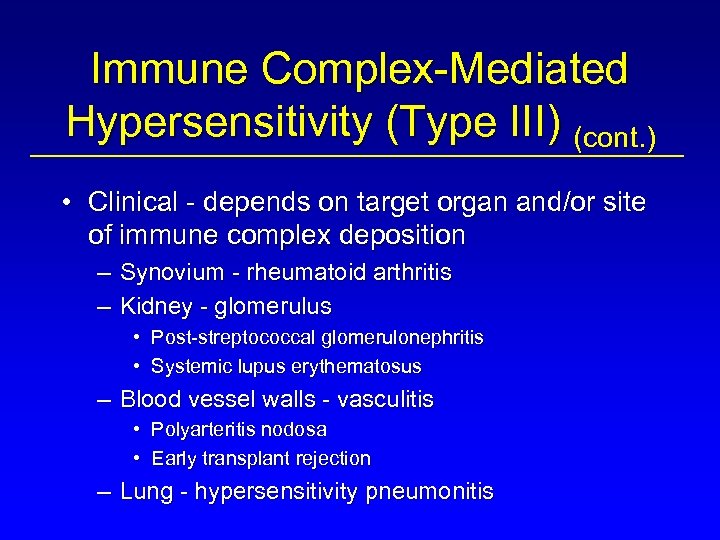 Immune Complex-Mediated Hypersensitivity (Type III) (cont. ) • Clinical - depends on target organ and/or site of immune complex deposition – Synovium - rheumatoid arthritis – Kidney - glomerulus • Post-streptococcal glomerulonephritis • Systemic lupus erythematosus – Blood vessel walls - vasculitis • Polyarteritis nodosa • Early transplant rejection – Lung - hypersensitivity pneumonitis
Immune Complex-Mediated Hypersensitivity (Type III) (cont. ) • Clinical - depends on target organ and/or site of immune complex deposition – Synovium - rheumatoid arthritis – Kidney - glomerulus • Post-streptococcal glomerulonephritis • Systemic lupus erythematosus – Blood vessel walls - vasculitis • Polyarteritis nodosa • Early transplant rejection – Lung - hypersensitivity pneumonitis
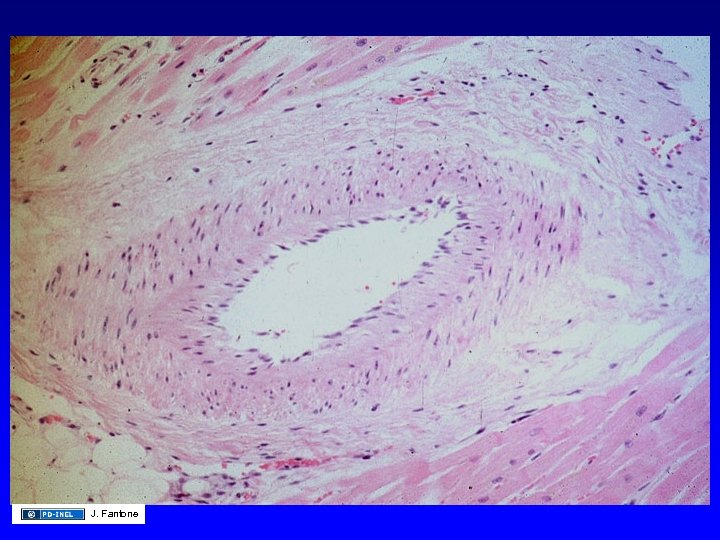 J. Fantone
J. Fantone
 J. Fantone
J. Fantone
 J. Fantone
J. Fantone
 J. Fantone
J. Fantone
 Source Undetermined
Source Undetermined
 Immune Complex Disease (post-streptococcal glomerulonephritis) • Irregular antigen distribution • Irregular antibody + complement distribution • Irregular secondary anti-human antibody to Ig. G or complement containing a fluorescent marker J. Fantone
Immune Complex Disease (post-streptococcal glomerulonephritis) • Irregular antigen distribution • Irregular antibody + complement distribution • Irregular secondary anti-human antibody to Ig. G or complement containing a fluorescent marker J. Fantone
 Immune Complex-Mediated Hypersensitivity (Type III) (cont. ) • Diagnosis – Skin tests for Type III reactions • Therapy – Elimination of antigen - as in transfusion reactions, hypersensitivity lung reactions to foreign antigens, and certain drug reactions – Corticosteroid and immunosuppressive therapy (cytoxan, cylosporin) – Plasmapheresis
Immune Complex-Mediated Hypersensitivity (Type III) (cont. ) • Diagnosis – Skin tests for Type III reactions • Therapy – Elimination of antigen - as in transfusion reactions, hypersensitivity lung reactions to foreign antigens, and certain drug reactions – Corticosteroid and immunosuppressive therapy (cytoxan, cylosporin) – Plasmapheresis
 Summary: Type II/III Reaction • • Antibody: Ig. M & Ig. G Effector Cells: Phagocytic Complement: Yes Reaction: 6 -24 hours
Summary: Type II/III Reaction • • Antibody: Ig. M & Ig. G Effector Cells: Phagocytic Complement: Yes Reaction: 6 -24 hours
 The four types of hypersensitivity reaction type ll allergen cell surface antigen lg. G target cell K lg. E cytotoxic action antibody Fc receptor mast cell degranulation mediator release complement mediated lysis type lll immune-complex deposition target cell type l. V antigens complement T inflammatory mediators blood vessel tissue basement membrane Source Undetermined lymphokines activated macrophage
The four types of hypersensitivity reaction type ll allergen cell surface antigen lg. G target cell K lg. E cytotoxic action antibody Fc receptor mast cell degranulation mediator release complement mediated lysis type lll immune-complex deposition target cell type l. V antigens complement T inflammatory mediators blood vessel tissue basement membrane Source Undetermined lymphokines activated macrophage
 Type IV: Cell-Mediated Immune Reactions • Objective – To define the primary mechanisms involved in contact hypersensitivity and delayed type hypersensitivity reactions – To review mechanisms of T-Cell mediated cytotoxicity (see Dr. King) • Cell Components – Mononuclear inflammatory cells: lymphocytes, monocytes/macrophages and antigen presenting cells
Type IV: Cell-Mediated Immune Reactions • Objective – To define the primary mechanisms involved in contact hypersensitivity and delayed type hypersensitivity reactions – To review mechanisms of T-Cell mediated cytotoxicity (see Dr. King) • Cell Components – Mononuclear inflammatory cells: lymphocytes, monocytes/macrophages and antigen presenting cells
 Source Undetermined
Source Undetermined
 Source Undetermined
Source Undetermined
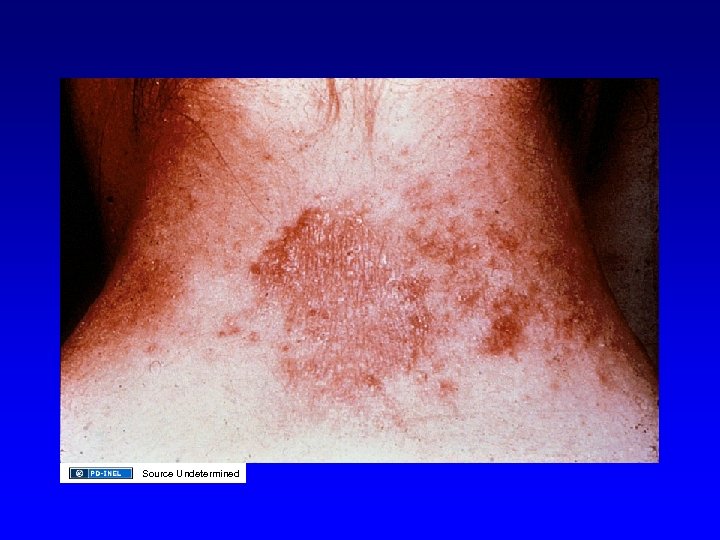 Source Undetermined
Source Undetermined
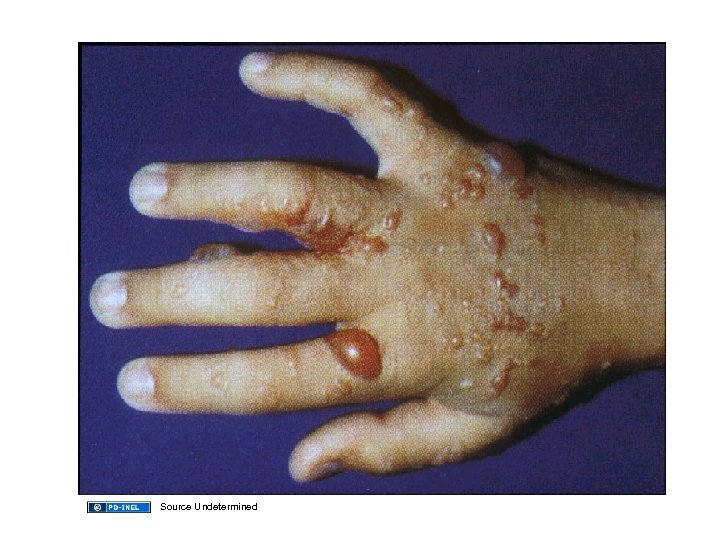 Source Undetermined
Source Undetermined
 Source Undetermined
Source Undetermined
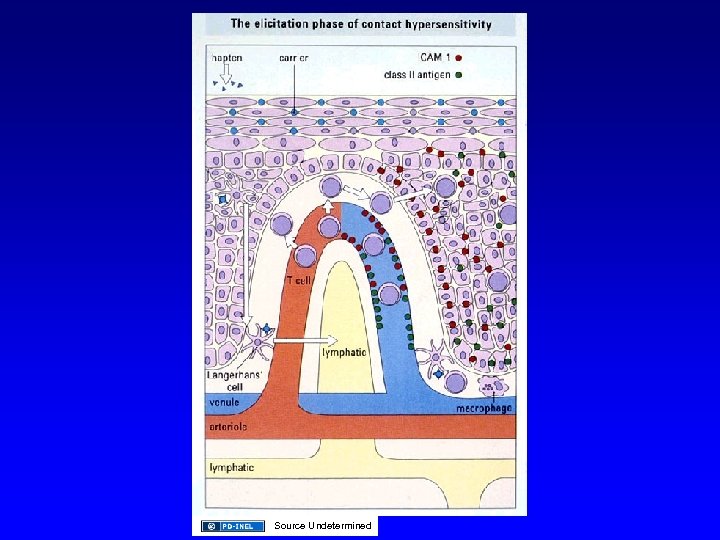 Source Undetermined
Source Undetermined
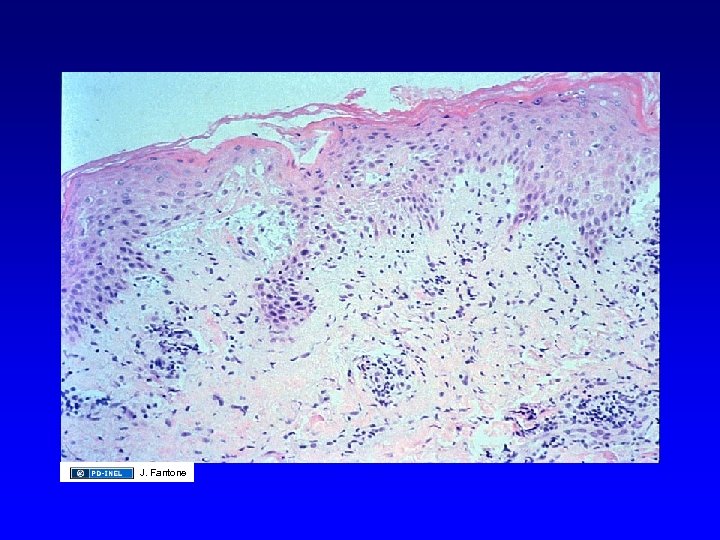 J. Fantone
J. Fantone
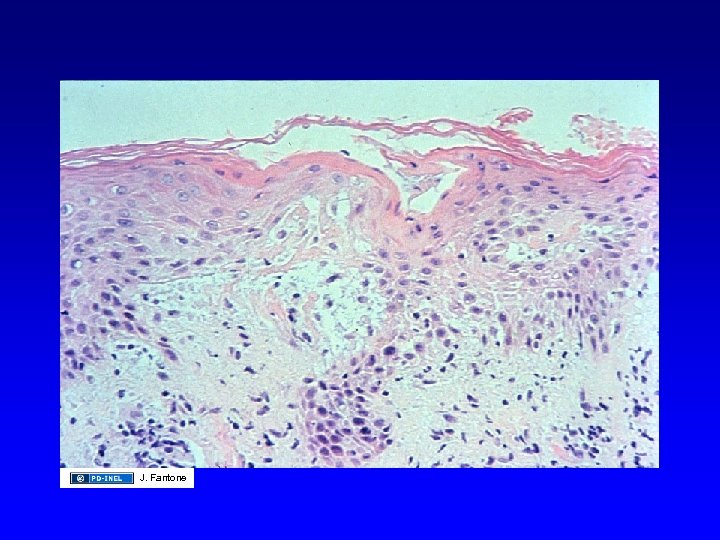 J. Fantone
J. Fantone
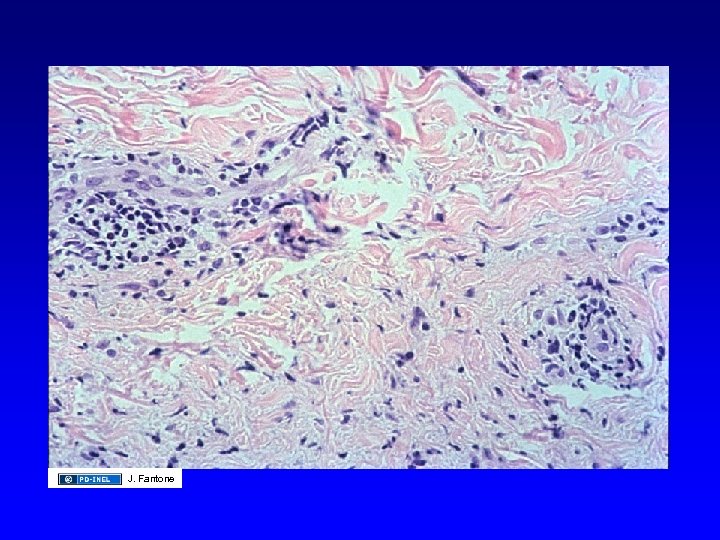 J. Fantone
J. Fantone
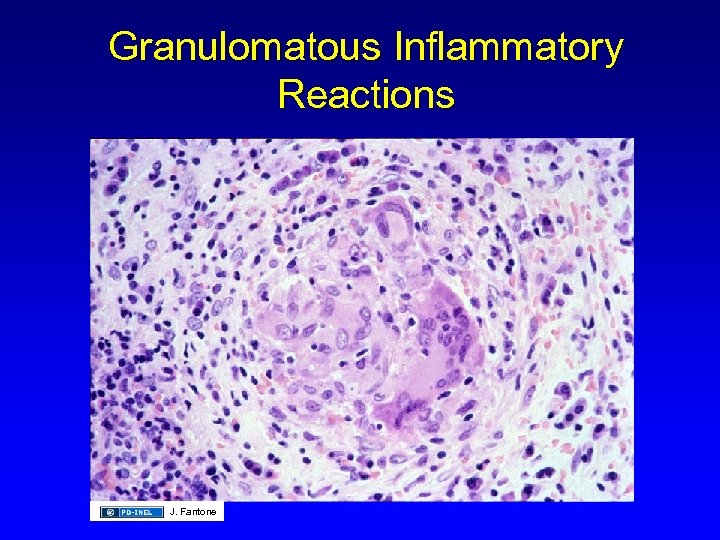 Granulomatous Inflammatory Reactions J. Fantone
Granulomatous Inflammatory Reactions J. Fantone
 J. Fantone
J. Fantone
 Summary: Type IV Reaction • Antibody: No • Effector Cells: T-lymphocytes, Monocyte/Macrophage • Complement: No • Reaction: 48 -72 hours (skin test)
Summary: Type IV Reaction • Antibody: No • Effector Cells: T-lymphocytes, Monocyte/Macrophage • Complement: No • Reaction: 48 -72 hours (skin test)
 Type IV: T-Cell Mediated Cytotoxicity (see Dr. King’s presentation) • Mechanisms – CD 8+ lymphocyte – Antigen expressed with Class I MHC – Interleukin-2 clonal expansion – Cytotoxic effector cell • Recognizes Ag+ class I MHC
Type IV: T-Cell Mediated Cytotoxicity (see Dr. King’s presentation) • Mechanisms – CD 8+ lymphocyte – Antigen expressed with Class I MHC – Interleukin-2 clonal expansion – Cytotoxic effector cell • Recognizes Ag+ class I MHC
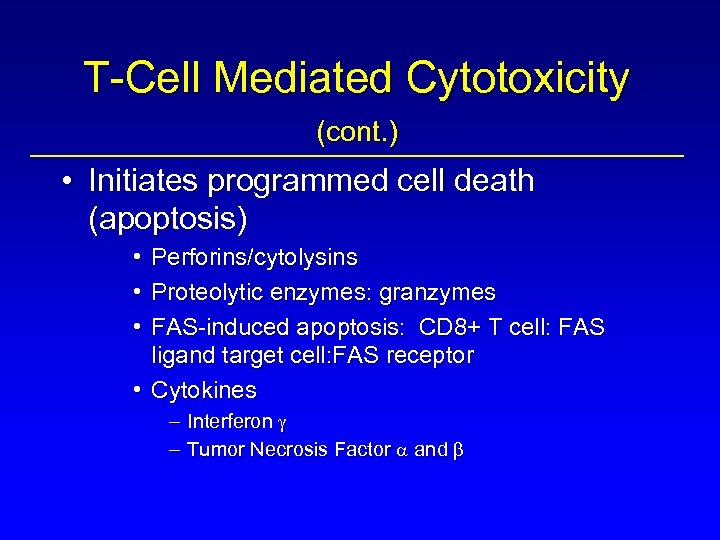 T-Cell Mediated Cytotoxicity (cont. ) • Initiates programmed cell death (apoptosis) • Perforins/cytolysins • Proteolytic enzymes: granzymes • FAS-induced apoptosis: CD 8+ T cell: FAS ligand target cell: FAS receptor • Cytokines – Interferon – Tumor Necrosis Factor a and b
T-Cell Mediated Cytotoxicity (cont. ) • Initiates programmed cell death (apoptosis) • Perforins/cytolysins • Proteolytic enzymes: granzymes • FAS-induced apoptosis: CD 8+ T cell: FAS ligand target cell: FAS receptor • Cytokines – Interferon – Tumor Necrosis Factor a and b
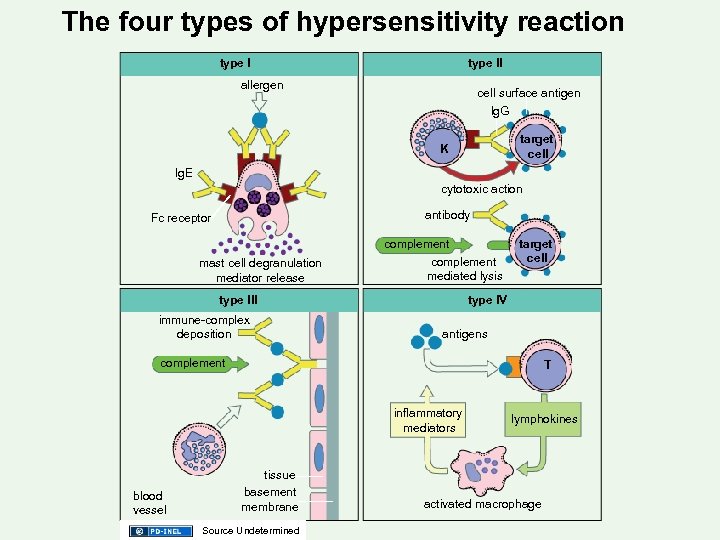 The four types of hypersensitivity reaction type ll allergen cell surface antigen lg. G target cell K lg. E cytotoxic action antibody Fc receptor mast cell degranulation mediator release complement mediated lysis type lll immune-complex deposition target cell type l. V antigens complement T inflammatory mediators blood vessel tissue basement membrane Source Undetermined lymphokines activated macrophage
The four types of hypersensitivity reaction type ll allergen cell surface antigen lg. G target cell K lg. E cytotoxic action antibody Fc receptor mast cell degranulation mediator release complement mediated lysis type lll immune-complex deposition target cell type l. V antigens complement T inflammatory mediators blood vessel tissue basement membrane Source Undetermined lymphokines activated macrophage
 Additional Source Information for more information see: http: //open. umich. edu/wiki/Citation. Policy Slide 4: Source Undetermined Slide 13: Source Undetermined Slide 14: Source Undetermined Slide 17: J. Fantone Slide 22: J. Fantone Slide 24: Source Undetermined Slide 28: Source undetermined Slide 29: J. Fantone Slide 30: J. Fantone Slide 33: Source Undetermined Slide 36: J. Fantone Slide 37: J. Fantone Slide 41: J. Fantone Slide 42: J. Fantone Slide 43: J. Fantone Slide 44: J: Fantone Slide 45: Source Undetermined Slide 46: Source Undetermined Slide 47: J. Fantone Slide 48: Source Undetermined Slide 50: J. Fantone Slide 51: J. Fantone Slide 52: Source Undetermined Slide 53: J. Fantone Slide 54: J. Fantone Slide 56: Source Undetermined Slide 58: Source Undetermined Slide 61: J. Fantone Slide 62: J. Fantone Slide 63: J. Fantone Slide 64: J. Fantone Slide 65: Source Undetermined Slide 66: J. Fantone Slide 69: Source Undetermined Slide 71: Source Undetermined Slide 72: Source Undetermined Slide 73: Source Undetermined Slide 74: Source Undetermined Slide 75: Source Undetermined Slide 76: Source Undetermined Slide 77: J. Fantone Slide 78: J. Fantone Slide 79: J. Fantone Slide 80; J. Fantone Slide 81: J. Fantone Slide 85: J. Fantone
Additional Source Information for more information see: http: //open. umich. edu/wiki/Citation. Policy Slide 4: Source Undetermined Slide 13: Source Undetermined Slide 14: Source Undetermined Slide 17: J. Fantone Slide 22: J. Fantone Slide 24: Source Undetermined Slide 28: Source undetermined Slide 29: J. Fantone Slide 30: J. Fantone Slide 33: Source Undetermined Slide 36: J. Fantone Slide 37: J. Fantone Slide 41: J. Fantone Slide 42: J. Fantone Slide 43: J. Fantone Slide 44: J: Fantone Slide 45: Source Undetermined Slide 46: Source Undetermined Slide 47: J. Fantone Slide 48: Source Undetermined Slide 50: J. Fantone Slide 51: J. Fantone Slide 52: Source Undetermined Slide 53: J. Fantone Slide 54: J. Fantone Slide 56: Source Undetermined Slide 58: Source Undetermined Slide 61: J. Fantone Slide 62: J. Fantone Slide 63: J. Fantone Slide 64: J. Fantone Slide 65: Source Undetermined Slide 66: J. Fantone Slide 69: Source Undetermined Slide 71: Source Undetermined Slide 72: Source Undetermined Slide 73: Source Undetermined Slide 74: Source Undetermined Slide 75: Source Undetermined Slide 76: Source Undetermined Slide 77: J. Fantone Slide 78: J. Fantone Slide 79: J. Fantone Slide 80; J. Fantone Slide 81: J. Fantone Slide 85: J. Fantone
